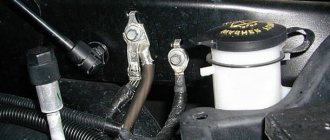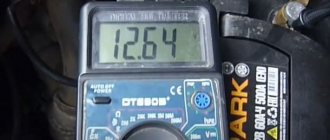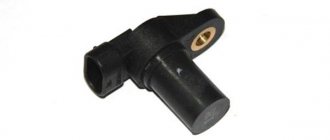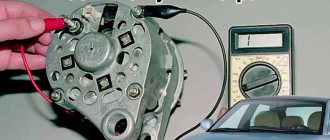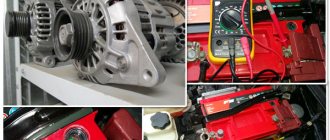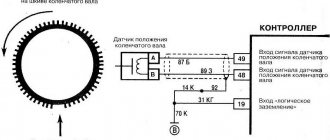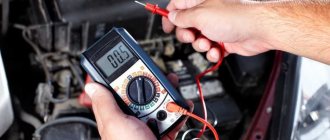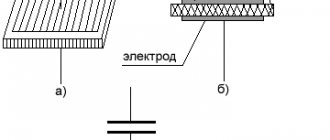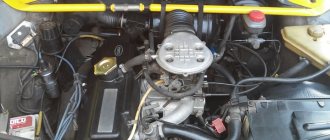When the car does not start for unknown reasons, you need to check the vehicle mass. The most convenient way is to use a multimeter. It's done like this:
- The voltage on the device is set to 2 V.
- One probe of the multimeter is connected to the vehicle body. The most cleared place is selected.
- The second dipstick is located on the engine.
- Readings are taken from the device.
The ground is considered weak if the number 1 V lights up on the display. To verify the weak strength, place one wire of the device on the negative terminal of the battery, and connect the second to the engine. Inflated data will indicate poor-quality mass contact.
Why is mass needed in a car?
Grounding the engine provides an electrical return path for the starter. Poor engine grounding is a common problem resulting in hard starting and no starting.
The following test takes a voltage drop reading to determine any unwanted resistance in the motor ground circuit.
- Disconnect the ignition or fuel system to prevent engine starting during testing.
If the ignition system has a distributor, you can disconnect the high voltage cable from the distributor cap and ground it to the engine (bolt or bracket) using a jumper wire. On other systems, you may be able to remove the fuel pump fuse. Consult your vehicle's owner's manual or vehicle repair manual to locate the fuse. You can also use a remote starter switch. Connect the switch to the starter relay or solenoid (selector relay) control circuit terminals.
- Set the DMM to a constant voltage and select a range as close as possible but greater than the battery voltage. For example, 20 volts. Or select the auto-ranging feature, depending on your multimeter's features.
- Connect the red meter lead to a clean surface of the engine and the black meter lead to the negative (-) terminal of the battery.
- Have a helper run the engine for about five seconds, this is enough to get a good current reading.
You should get a reading of 0.2 volts or less. If necessary, refer to your manufacturer's specifications in your vehicle's repair manual. Did you get a higher reading? There is unwanted resistance in the ground circuit. To find the problem, proceed to the following steps.
- Move the red lead of your meter to the main ground terminal on the engine side.
- Have a helper crank the engine while you take a voltage drop reading.
Repeat the previous two steps, moving the red wire to the connector connecting the black main ground wire to the battery terminal. When you get a reading around 0.2V or lower, the unwanted resistance is between this and the previous test point. Check for corrosion, broken or loose wires.
Common machine electrical faults
Auto electrics include various systems, parts, devices and elements of the vehicle - the ignition system, battery and generator, on-board computer circuits, fuses, sensors, relay blocks, various electronic sensors, auto lights, as well as auto electronics - climate system, audio system, automation and systems security. It is necessary to take into account the peculiarities of automotive electrical wiring in order to quickly find and eliminate a malfunction in the on-board network.
Common electrical problems include:
- Battery failure. This may be a consequence of insufficient electrolyte density, damage to the case with electrolyte leakage, destruction of the plates, or significant oxidation of the battery terminals.
- Generator breakdowns - winding breaks, problems with the voltage relay, failure of the diode bridge, wear of brushes and bearings.
- Problems with the ignition system. We are talking about malfunctions of spark plugs, ignition coils, an open circuit or oxidation of the contact group.
- Deformations of electrical wiring - oxidation at connection points (inputs, contacts, terminals), breaks, destruction of wire insulation, short circuit of wiring, violation of the integrity of twists.
- Failure of electronic components. This refers to malfunctions of various electrical devices in circuits, devices and electrical equipment of a car (conductors, diodes, fuses, capacitors).
Checking grounding in a car
Electronic modules and many electrical components in the engine, transmission and passenger compartment use the body as an electrical ground. This test checks for unwanted resistance at these points, including the secondary ground between the battery and chassis used by some older models. If necessary, consult your vehicle's repair manual.
- Connect the black lead of your meter to the battery (-) terminal and the red lead of your meter to where the wire connects to the body.
- Have a helper crank the engine for a few seconds.
You should get a voltage drop of 0.2V or less. If the voltage drop is higher, proceed to the next steps.
- Move the red lead of your meter to the terminal on the end of the secondary ground wire. Take voltage drop readings.
If you get a reading higher than 0.2 volts, proceed to the next step.
- Move your meter's red test lead to the next terminal and ground point. Take voltage drop readings at each point.
When you get a reading around 0.2V or lower, the unwanted resistance is between this and the previous test point. Check for corrosion, broken or loose wires.
Also, check the voltage drop on the ground circuits that connect the engine to the chassis.
Search, check and replace transfer grounds if necessary.
Instead of an afterword
Afterwards you will find out the actual mileage, number of owners, history of fines, as well as information about theft, participation in an accident, restrictions on car registration and much more. Be carefull!
Having fully studied the online report, it is still worth taking a closer look at the technical nuances of the car when purchasing. And if you are not confident in your knowledge, or it is not possible to go for an inspection, order an on-site inspection service. The specialist will conduct a diagnosis for you and make a detailed conclusion from a professional point of view.
Source
Troubleshooting
For uninterrupted operation of the battery, the system must be equipped with good quality wires; in this case, copper wires are the most suitable, since they have the best characteristics when operating under voltage.
The thin positive wire coming from the generator must be replaced with a thicker wire.
To protect the existing mass and ensure longer and more trouble-free operation, it is necessary to treat all existing connections and terminal contacts with a special lubricant that has an anti-oxidation function.
You can strengthen the mass by placing additional mass near the generator. Of course, you should not use a thin negative wire to connect to the car body; it is better to use a thick wire. The result will be better, and if problems arise with the main wire, the additional one will be able to start the car, and again you will not have to listen to the clicking of the relay.
As a result of the procedures performed, the car will start more confidently. We will eliminate the problem of frequent battery discharge, which will avoid the loss of much-needed volts for the car and, as a result, ensure the most stable and sufficiently high voltage coming from the generator.
Maximum vehicle weight with trailer
The maximum permissible weight of trucks and trailers is regulated by laws and regulations. According to the law, a truck can tow any trailer. At the same time, the maximum permissible weight of a car with a trailer is affected by the category and design of the vehicle.
Maximum total weight:
- 2-axle vehicles with a trailer - no more than 18 tons;
- 3-axle - no more than 24 tons;
- 3-axle with a drive axle having two pairs of wheels - up to 25 tons.
If you are going to use a trailer for transportation, then the load must be distributed so that the maximum pressure on the tow bar (a towing device designed for towing trailers) is 60–80 kg.
If you exceed this norm, there may be a problem with the traction of the front wheels. If it is not up to standard, problems will arise with the rear wheels.
Indicators of permissible vehicle weights have important practical significance. Almost all of them have duplicate terminology that drivers use
In order not to get confused in terminology and numbers and not get into a problematic situation on the road, before operation it is useful to familiarize yourself with all the technical characteristics of the car, including weight indicators.
What is engine demining?
Structurally, the car has a developed electrical system, in which the serviceability and accuracy of the controllers, various sensors and many other electrical devices depend on the mass. The electrical ground (minus) is connected from the battery to the car body. The body is conventionally a return wire, forming a closed electrical circuit.
The movement of electrons along the circuit is initiated by the battery, and the body acts as a conductor of negative charge for return via the negative terminal. For this reason, the metal body of a car is called car body. In this case, engine demining should be understood as a number of improvements that involve additional connection of the most powerful consumers of electricity in the car to ground.
Purpose
The main purpose of the mass switches has not changed since the last century:
- disconnecting the battery from the on-board network during parking;
- if there are two batteries in the vehicle, disconnect the backup battery;
- as a simple anti-theft device.
Modern car thieves have forgotten about the simplest tricks of car enthusiasts, so if you properly hide the VM in the engine compartment, this option may not occur to them.
In modern cars, stuffed with electronic devices and units, current leaks often occur while the car is parked, which are difficult to eliminate. Main consumers of current during parking:
- car radio;
- security device (car alarm);
- body control unit.
It is considered normal if a car consumes up to 200 milliamps of current while parked (usually about 20-70 milliamps). For a day this is about 5 ampere-hours, for 10 days - 50 ampere-hours. That is, after 10 days of parking, a car battery can be almost completely discharged. This usually happens in about a month. Thus, if you leave the car for a long winter, the battery will be discharged to almost zero in the spring. This is very dangerous from the point of view of sulfation of the plates, which leads to complete failure of the battery.
The main switch allows you to avoid battery discharge due to leakage currents during parking.
VMs are widely used in agricultural machinery, for example, for tractors:
And on heavy-duty equipment - for example, a KAMAZ remote load switch:
Automotive wiring wire cross-section
To correctly calculate the wire cross-section for automotive wiring, you need the following data:
- maximum current consumption of connected electrical equipment in the car;
- the distance from the equipment to the power source (battery), that is, the length of the wire;
- rated voltage of the power supply.
To quickly select the wire cross-section, it is enough to know the maximum current strength and use the ready-made table. There are maximum current standards for each standard cross-section, but this method is only applicable for short electrical circuits.
| Wire cross-section, mm2 | Permissible current (A) depending on the ambient temperature, C | |||
| 20 | 30 | 50 | 80 | |
| 0,5 | 17,5 | 16,5 | 14 | 9,5 |
| 0,75 | 22,5 | 21,5 | 17,5 | 12,5 |
| 1 | 26,5 | 25 | 21,5 | 15 |
| 1,5 | 33,5 | 32 | 27 | 19 |
| 2,5 | 45,5 | 43,5 | 37,5 | 26 |
| 4 | 61,5 | 58,5 | 50 | 35,5 |
| 6 | 80,5 | 77 | 66 | 47 |
There is also an unspoken rule among auto electricians that for every 1mm2 of cross-section the connected load is 10A.
Below is a table taking into account the maximum wire length from a 12V power source to electrical equipment with a voltage drop of less than 2%
| Current, A | Cable cross-section, mm2 | |||||||||||
| 1 | 1,5 | 2,5 | 4 | 6 | 10 | 16 | 25 | 35 | 50 | 75 | 100 | |
| 1 | 7 | 10,91 | 17,65 | 28,57 | 42,86 | 70,6 | 109,1 | 176,5 | 244,9 | – | – | – |
| 2 | 3,53 | 5,45 | 8,82 | 14,29 | 21,4 | 35,3 | 54,5 | 88,2 | 122,4 | 171,4 | – | – |
| 4 | 1,76 | 2,73 | 4,41 | 7,7,14 | 10,7 | 17,6 | 27,3 | 44,1 | 61,2 | 85,7 | 130,4 | – |
| 6 | 1,18 | 1,82 | 2,94 | 4,76 | 7,1 | 11,7 | 18,2 | 29,4 | 40,8 | 57,1 | 87 | 117,6 |
| 8 | 0,88 | 1,36 | 2,2 | 3,57 | 5,4 | 8,8 | 13,6 | 22 | 30,6 | 42,9 | 65,25 | 88,2 |
| 10 | 0,71 | 1 | 1,76 | 2,86 | 4,3 | 7,1 | 10,9 | 17,7 | 24,5 | 34,3 | 52,2 | 70,6 |
| 15 | – | 0,73 | 1,18 | 1,9 | 2,9 | 4,7 | 7,3 | 11,8 | 16,3 | 22,9 | 34,8 | 47,1 |
| 20 | – | – | 0,88 | 1,43 | 2,1 | 3,5 | 5,5 | 8,8 | 12,2 | 17,1 | 26,1 | 35,3 |
| 25 | – | – | – | 1,14 | 1,7 | 2,8 | 4,4 | 7,1 | 9,8 | 13,7 | 20,9 | 28,2 |
| 30 | – | – | – | – | 1,4 | 2,4 | 3,6 | 5,9 | 8,2 | 11,4 | 17,4 | 23,5 |
| 40 | – | – | – | – | – | 1,8 | 2,7 | 4,4 | 6,1 | 8,5 | 13 | 17,6 |
| 50 | – | – | – | – | – | – | 2,2 | 3,5 | 4,9 | 6,9 | 10,4 | 14,1 |
| 100 | – | – | – | – | – | – | – | 1,7 | 2,4 | 3,4 | 5,2 | 7,1 |
| 150 | – | – | – | – | – | – | – | – | – | 2,3 | 3,5 | 4,7 |
| 200 | – | – | – | – | – | – | – | – | – | – | 2,6 | 3,5 |
Example: It is necessary to connect a radio, the wire length is 2 meters of wire, the current is 15 amperes. According to the table, we are looking for the closest data for this task. According to the table, it turns out that a cross-section of 6 mm2 is suitable for us,
For a more accurate calculation of the wire cross-section for automotive wiring, we recommend contacting specialists.
The Cable Systems company carries out wholesale and retail sales of wires for automotive wiring. We will help you choose the right brand for your case!
| Need a wire for your car? Submit your application online or call our toll free number 8 |
